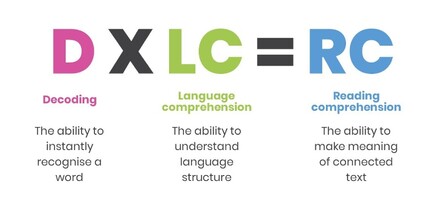A reflection of my Chit Chat with Distinguished Professor Emeritus William Tunmer, PhD.
Why Johnny Can't Read—And What You Can Do About It is a 1955 book-length exposé on American reading education by Rudolf Flesch, which in essence urged a return to phonetic methods.
Two years before this book was first published, well-known Distinguished Professor Emeritus William Tunmer was beginning his journey in California, USA as a 5 -year-old child being taught to read with an approach that was sweeping the nation in the 1950s. This approach used flashcards, with high-frequency words taught first. He was not taught word families or patterns (not a phonic in sight) and little did he know at the time, after six months of learning he could not read a word.
He reflects on his father being transferred to Cheyenne Wyoming as his “lucky break”.
He moved to a new school and a new teacher, Mrs Anderson, who taught Prof Tunmer reading through traditional phonics. By the end of the year, he had caught up with his peers. Lucky for him.
Who knew, that back then when Prof Tunmer was first learning to read, he’d become Distinguished Professor Emeritus of Educational Psychology at Massey University and co-develop the Simple View of Reading. His reflection of this story when I recently connected with him through a Chit Chat was truly fascinating to listen to.
As we moved through the Chat Chat to discuss the origins and evolution of the Simple View of Reading, Professor Tunmer describes the events that led to its development.
Learning to Read: The Great Debate. Look say vs traditional phonics
Prof Tumner recalls there was quite a divergence between views during the 60s. Much of the debate was noted in the book Learning to Read: The Great Debate written by Jeanne Chall. Although research was carried out, over the following decades education mainly practised the views of two researchers, Kenneth Goodman and Frank Smith. Goodman and Smith argued against any phonics instruction and championed a Whole Language approach, which is against breaking language up into phonemes and has multiple cues.
These views became very dominant in education across America and the globe.
The origins and development of The Simple View of Reading
Prof Tumner reflects on his time as an Invited Scholar to research Cognitive Science at the University of Texas to give a different perspective on how children become readers.
He states, “We knew the model being promoted by Goodman Smith was very popular in education factors. We wanted to develop a model that would provide a counter to that. But a model that was simple in its structure not in its components.” He also mentions by 1980, “It was pretty well known within the scientific community that those views (Goodman and Smith) were incorrect,” which I personally find fascinating.
During this time, he (and other scholars) focused on advancing the understanding of human cognition. To gain perspective on how children become readers, they looked from the child’s point of view and what they were facing when learning to read. “Understanding spoken language is essential. It was an assumption that without knowledge of the language being read, reading couldn’t take place.” The fundamental task facing the child is to figure out how print on a page maps onto their spoken language.
Understanding that the word recognition component combined with the language comprehension component brought to the development of the Simple View of Reading in 1986 by Gough and Tunmer.
Prof Tunmer stresses that it’s called the Simple View of Reading because the STRUCTURE is simple, not the components, “It’s a complicated system," and that reading comprehension is always the end game in the overall picture.
Delving deeper – the Cognitive Foundations Framework
It was so wonderful for Prof Tunmer to share where the Simple View of Reading (SVR) had originated from. We then led into a fantastic conversation about how the SVR has continued with development from its creation and discussed the Cognitive Foundations Framework (CFF).
What the CFF helps to do is further break down the capacities that sit within language comprehension and the capacities that sit with word recognition skills. It also explains the interplay between these areas, which is so beneficial to understand.
Understanding the interplay really helps teachers and intervention specialists to answer, 'what we are doing' and 'why we are doing it'. Professor Tunmer also reveals the purpose of the CFF is to provide a roadmap for teachers and intervention specialists to understand what readers know and what they need to know, which can help prevent reading problems before the need for intervention, plus help determine where some children might be struggling. It also highlights the importance of targeted evidence-based instruction, rather than on-mass.
Why does the pendulum swing back and forth?
When discussing outcomes he’d like to see for the future, Prof Tunmer mentions it would be great if the pendulum swing finally stopped at a phonics-based approach.
He also points out that phonics itself should be seen as a means-to-an-end, not an end itself and stresses that making use of the letter-sound connections plays such an important part of the process to becoming a successful reader. “There’s no evidence you can do it the way I was originally taught to read, to try to recognise words as whole word visual patterns."
There are still some thoughts that phonics does not benefit all children. Prof Tunmer pointed out that children need to have phonemic awareness intact to attach phonics (letters and sounds) onto. The common misconception here is that phonics alone is enough. The science is clear on this as is the Simple View of Reading; we MUST teach decoding skills coupled with language comprehension indeed BUT... we must teach ALL components within each element and understand the interplay between these to build successful readers.
I thoroughly enjoyed talking with Prof Tunmer and agree with him wholeheartedly when he closes our Chit Chat with the final remark, “Science is important – listen to the science”.
Article links
You can view the full Chit Chat here.
Cognitive Foundations Framework article information:
William E. Tunmer & Wesley A. Hoover (2019) The cognitive foundations of
learning to read: a framework for preventing and remediating reading difficulties, Australian Journal of Learning Difficulties, 24:1, 75-93, DOI: 10.1080/19404158.2019.1614081
Article Abstract:
This article presents an overview of a conceptual framework designed to help reading professionals better understand what their students are facing as they learn to read in alphabetic writing systems. The US National Reading Panel (NRP) recommended five instructional components for improving reading outcomes but presented these instructional components as a list without explicitly addressing their interrelations, either in terms of instruction or cognitive development. In contrast, the Cognitive Foundations Framework offers a description of the major cognitive capacities underlying learning to read and specifies the relationships between them. The central claim of this article is that what is needed to help intervention specialists achieve better outcomes is a clearly specified conceptual framework of the cognitive capacities underlying learning to read that provides the basis for an assessment framework that is linked to evidence-based instructional strategies for addressing the individual literacy learning needs of students.
Unfortunately Learning MATTERS does not have the correct permissions to share the article.
If you wish to purchase the article independently please use the following link:
https://www.tandfonline.com/doi/full/10.1080/19404158.2019.1614081?scroll=top&needAccess=true
Carla McNeil
Carla is the Founder and Director of Learning MATTERS Ltd. Carla has been a successful school Principal, Mathematics Advisor and Classroom teacher.









